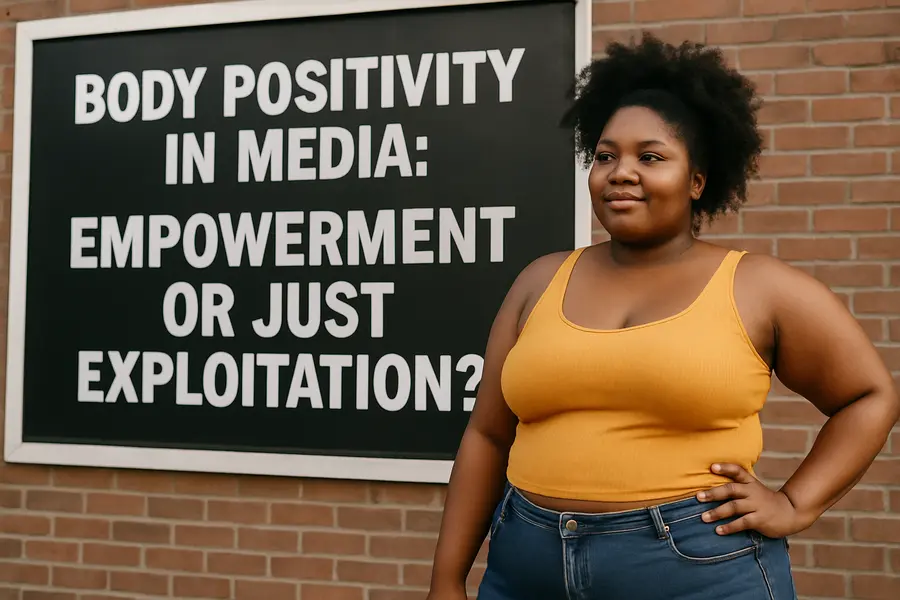Is body positivity in media truly empowering, or just clever marketing?
Body positivity in media can be empowering—it helps people feel confident in their own skin and challenges unrealistic beauty standards. But sometimes, it’s used as a marketing tool, not a genuine movement.
Brands may promote diversity just to boost sales, not to support real change. So, while it can uplift and inspire, we need to ask: is it authentic or just trendy?
True empowerment comes when media listens, represents honestly, and respects all bodies—not just profits.
Let’s explore how representation can uplift or exploit, and why authenticity matters when it comes to celebrating all bodies in today’s media culture.

Body Positivity in Media Culture: Empowerment or Exploitation?
The body positivity movement has exploded across social media and advertising, promising liberation from oppressive beauty standards.
What began as radical fat acceptance activism has become mainstream, with #BodyPositivity amassing over 9 million Instagram posts. But beneath the surface of this cultural phenomenon lies a critical question: Is media’s embrace of body diversity genuine empowerment, or just another form of exploitation?
Body image concerns affect 90% of girls and increasingly impact boys and gender-diverse individuals.
Traditional media established narrow ideals, but social media intensified this crisis through constant exposure to curated images and algorithms promoting comparison.
Simultaneously, marginalized communities pioneered online spaces celebrating diverse bodies—creating both healing opportunities and new commercialization risks. This paradox defines today’s body positivity landscape: a tool for self-acceptance fighting against co-option by the same systems it challenges.
As we examine its evolution, psychological impacts, and commercial forces, we uncover whether this movement can truly transform societal values or merely rebrand them.
Explore body positivity in media: empowerment movement or exploited trend? Unpack social media’s impact on self-image, commercial co-option & paths to genuine inclusivity.
From Radical Roots to Mainstream Message: The Evolution of Body Positivity
The body positivity movement emerged not from corporate boardrooms but from marginalized activists.
In 1969, the National Association to Advance Fat Acceptance (NAAFA) launched the fat acceptance movement, primarily led by fat, Black, and queer women fighting systemic discrimination. Their mission wasn’t personal empowerment but justice—challenging stereotypes linking larger bodies to laziness or poor health, and demanding dignity in workplaces, healthcare, and society.
This activism directly confronted industries profiting from body shame, notably the $224 billion diet industry.
Social media’s rise in the 2010s catapulted these ideas mainstream.
Hashtags like #BodyPositivity spread rapidly, creating visibility for diverse bodies. However, this popularity diluted the movement’s radical core.
Brands co-opted the language, featuring “acceptable” diverse models—often white, hourglass-figured, or conventionally attractive—while ignoring truly marginalized bodies.
As one analysis noted: “Thin, white influencers became the face of a movement meant to uplift those most marginalized”.
The focus shifted from systemic change to individual self-love, exemplified by Dove’s “Real Beauty” campaign.
While groundbreaking in showcasing diversity, such initiatives rarely addressed weight discrimination or healthcare inequities.
This commercialization created a paradox: while 71% of women over 50 still report weight concerns, “body positivity” became marketable.
Brands sold products using diverse models while perpetuating consumption-driven beauty culture.
The 2024 rise of Ozempic and ‘ballet body’ trends further exposed this tension, with celebrities and influencers promoting extreme thinness again.
True movement reclamation requires supporting fat activists, demanding policy changes, and recognizing that body neutrality—valuing function over appearance—can be as valid as constant positivity.
Read Here: The Evolution of Body Positivity in Media Culture
The Double-Edged Filter: Empowerment vs. Exploitation in Media
Social media algorithms act as both bridge and barrier for body image. Platforms like Instagram prioritize engagement, flooding users with idealized images that trigger comparison and dissatisfaction.
Studies confirm that just 1.6 hours daily on image-based platforms correlates with increased body dysmorphia and eating disorder risks—especially among teens receiving phones at ages 12-13, coinciding with peak Body Dysmorphic Disorder onset.
The rise of beauty filters exacerbates this; 47% of 18-29-year-olds use them, blurring reality and ideals.
Yet these same platforms host thriving body-positive communities. Research reveals that exposure to diverse-body content significantly improves body satisfaction:
- Women viewing 1-2 body-positive posts daily for two weeks reported lasting reductions in body dissatisfaction.
- Body-positive Instagram content increased body appreciation in 79% of women across ages 18-76.
- Content focusing on body functionality (e.g., “what bodies can do”) outperformed appearance-focused positivity.
However, empowerment is often co-opted. Brands engage in “performative inclusivity”—using diverse models while selling weight-loss teas or editing photos.
Luxury fashion weeks in 2024 revealed declining plus-size representation, with only London and Copenhagen making strides through smaller, progressive designers.
Meanwhile, “body positive” influencers face pressure to conform; posts featuring slightly curvy but still hourglass-shaped bodies gain more traction than those showcasing disabled or truly larger bodies.
The solution lies in conscious consumption:
- Curate feeds to follow diverse creators (e.g., @mynameisjessamyn, @sonyareneetaylor).
- Demand transparency about photo editing and filters.
- Support ethical brands like Universal Standard or Y.O.U Underwear, which integrate inclusivity into sizing and marketing.
As researcher Jasmine Fardouly notes: “Algorithms could promote body-positive content, but platforms prioritize profit over wellbeing” 4. Users must therefore hack the system through intentional engagement.
Mind over Media: Body Positivity’s Psychological Impacts
The mental health consequences of media’s beauty standards are staggering. Body dissatisfaction is the strongest predictor of eating disorders, affecting 80% of 17-year-old girls.
Social media amplifies this via “appearance comparison loops”: users who frequently compare themselves to others score 8.5 points higher on body dissatisfaction scales.
For gender-diverse youth, these issues intertwine with gender dysphoria, increasing risks of extreme dieting.
Body-positive media offers measurable relief. A meta-analysis of 56 studies found that exposure to body-positive content:
- Boosts immediate body satisfaction and mood.
- Reduces self-criticism more effectively than fitspiration (“fitness inspiration”) content.
- Creates sustained improvement with regular exposure.
Notably, a University of New South Wales study demonstrated that women viewing body-positive posts daily for two weeks maintained improved self-image four weeks later—suggesting lasting neural rewiring.
However, limitations exist. Self-objectification paradoxically increases with both body-positive and thin-ideal content, as both focus attention on physical form.
Body positivity also struggles to counter deeply ingrained weight stigma; participants in larger bodies showed less improvement in body functionality appreciation.
Practical interventions include:
- Reducing social media use by 50% improves body esteem within weeks.
- Cognitive Behavioral Therapy (CBT) counters distorted body thoughts.
- Body functionality journals focusing on non-appearance attributes (e.g., “My legs carried me 3 miles”)
As psychologist Dr. Fardouly emphasizes: “We need to see diverse bodies to challenge ideals, but media literacy is crucial” .
Reclaiming the Narrative: Future Paths for Body Positivity
The body positivity movement stands at a crossroads in 2025. Commercialization and trends like Ozempic threaten its radical roots, yet research-backed strategies offer paths forward.
Systemic change must precede individual empowerment:
- Policy advocacy: Banning weight discrimination in employment (like Michigan’s laws) and regulating cosmetic surgery ads targeting youth.
- Healthcare reform: Ending BMI-based treatment denials and training providers on weight-neutral care.
- Industry accountability: Mandating disclosure of edited images (as Norway’s law requires) and diverse size representation at Fashion Weeks.
Media platforms must optimize algorithms to promote genuine diversity. Currently, Instagram’s algorithm favors engagement, amplifying extreme content.
Restructuring it to prioritize body-positive creators—especially those with disabilities, racial diversity, and larger bodies—could reduce harm.
Pinterest’s 2022 ban on weight-loss ads demonstrates this potential..
For individuals, embracing body neutrality offers respite from the pressure to “love” every flaw.
As one advocate notes: “My worth isn’t tied to loving my stretch marks; it’s in existing without apology”.
Tactics include:
- Unfollowing accounts prompting comparison (even if “inspirational”)
- Engaging with #BodyFunctionality or #BodyNeutrality content
- Supporting ethical brands like Y.O.U Underwear that avoid tokenism 14
The movement’s future hinges on recentering intersectional voices. Initiatives like The Butterfly Foundation’s youth programs and NAAFA’s policy work model this shift.
As designer Olivia Rubens states: “True inclusivity means hiring diverse designers, not just models”.
Final Verdict: Empowerment with Conditions
Body positivity in media culture is neither pure empowerment nor outright exploitation—it’s a battleground.
Its power emerges when media platforms amplify marginalized voices, promote unedited diversity, and prioritize well-being over engagement metrics.
Studies confirm body-positive content can improve self-image and challenge harmful ideals. However, its commercialization by brands and influencers often reduces it to a marketing tactic, divorced from its activist roots.
The movement’s success hinges on two conditions: reclaiming its political foundation and demanding systemic change.
Empowerment occurs only when the media uplifts the very bodies it historically excluded—without selling them weight-loss supplements in the next post.
As consumers, we must critically engage, support ethical creators, and remember: Radical self-acceptance is revolutionary, but revolution requires more than self-love.





